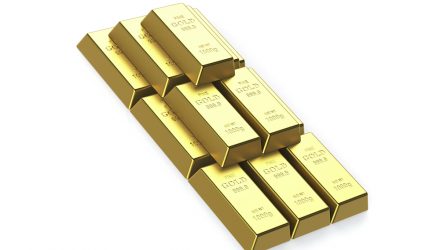With stock dumping this week in the worst losses since March and volatility ramping up, investors are fleeing into traditional safe-haven assets like gold and Treasurys, spurring moves in both those markets and their accompanying ETFs.
Gold, which has been rangebound since early April after moving higher since March along with stocks, is getting a boost this week, as market volatility is stimulating higher prices amid increasing concerns about the U.S. economic recovery and the second coronavirus wave.
While the precious metal appeared to be breaking down along with bonds beginning in mid-May and continuing up until last week, gold has reversed many of its worst losses this week, 3.5% since last Friday’s close after the Federal Reserve suggested that the recovery could be a much lengthier process than many investors have anticipated.
Analysts are maintaining a generally mostly bullish on gold next week but are still unsure as to whether gold will manage to breach the $1,800 level.
“Volatility is back and this is what we should be paying attention to. We could see bigger swings in gold. Volatility is bullish for gold and it would deter some risk-on sentiment,” said Gainesville Coins precious metals expert Everett Millman.
Give Me The Gold
Gold ETFs, he GraniteShares Gold Trust ETF (BAR) and the SPDR Gold MiniShares ETF (GLDM) also both finished slightly positive on the day, and are trading near five year highs.
The Fed disappointed investors who were betting on a rapid, v-shaped economic recovery in the U.S., which led to a significant decline in stocks this week.
On Wednesday, the central bank kept interest rates unchanged and signaled no rate hikes through 2022. The Fed reiterated that it is committed “to use its full range of tools” to support the U.S. economy and projected for the U.S. GDP to contract by 6.5% this year.
In addition, according to Centers for Disease Control and Prevention official comments on Friday, states may be required to reimplement the strict social distancing measures that were enacted earlier this year if U.S. coronavirus cases climb “dramatically.”
“Right now, communities are experiencing different levels of transmission occurring, as they gradually ease up onto the community mitigation efforts and gradually reopen,” CDC’s Deputy Director for Infectious Diseases Jay Butler told reporters during a press briefing.
He said the decision to reimplement measures will have to be made locally and based on “what is happening within the community regarding disease transmission.”
The Pandemic Is Not Over
The “pandemic is not over” and it’s important to recognize that Covid-19 is still making headlines everywhere, he added.
Next week, markets could still be busy pricing in their reaction to the Fed’s meeting, Millman said. “Investors hang on to what the central bank says … and the Fed’s outlook dampens the general confidence. Plus, the economic data is going to be bad. Markets will be searching for direction. This is a tailwind for gold,” he noted.
Low inflation pressures could still stymie gold from climbing too much next week, TD Securities head of global strategy Bart Melek pointed out.
“Gold has increased in volatility quite a bit … and it is close to breaking through,” Melek said Friday. “But it might be premature for an outright breakthrough. Looking at low-end around $1,700 and on the high-end at $1,757 … There are issues down the road in the form of weak inflation.”
In the long-term, however, Melek is very bullish on gold, stating that once inflation kicks late next year, gold will reach $2,000 an ounce.
Next week, the markets might be entering an in-between period, where investors choose to wait before committing to the market one way or the other, noted SIA Wealth Management chief market strategist Colin Cieszynski.
“I am neutral on gold and looking for a sideways trend between $1,655-$1,765,” Cieszynski told Kitco News on Friday. “For the next few weeks, we are probably going to see a lot of neutrality across a lot of markets as we are heading into mid-point of the year. There is a ton of positive and negative news and people are waiting to see how things shake out … Central banks unleashed all this stimulus and there is not going to be anything new coming for awhile. Markets are stabilizing.”
Millman is slightly more bullish in the short-term, widening his next week’s range to include $1,800 an ounce. “Given the volatility, my range has extended. On the upside, I am looking at $1,800 and downside $1,650,” he said.
For more market trends, visit ETF Trends.
